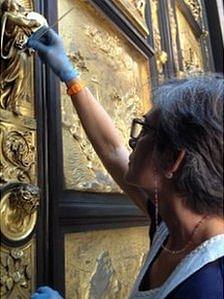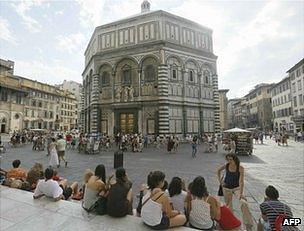Florence to return art treasure to public view
- Published
Alan Johnston reports on the renovation of Lorenzo Ghiberti's "Gates of Paradise", shown before (left) and after restoration
All day, every day, there is a crowd around the Baptistery of San Giovanni in the heart of Florence.
The striking, black and white, eight-sided building is one of the city's architectural glories.
But mostly, the tourists pause for a moment to look up at a famous set of doors.
They crane their necks and snap away with cameras as they take in the golden gates that fill the baptistery's main entrance.
Fine as they are, the doors are only replicas, paid for by a Japanese millionaire.
Lorenzo Ghiberti's original, Renaissance masterpiece - The Gates Of Paradise - has had to be hidden from public view for more than two decades.
It has been undergoing what is one of Florence's most important restoration projects.
The work has taken 27 years to complete.
But with the finishing touches now at last being applied, the BBC has been given access to the Gates - and they are magnificent.
'New way of making'
This is a towering, nine-tonne work of art, wrought out of bronze and layered with gold more than 500 years ago.

The restoration has taken almost three decades
In scene after scene, countless figures, sculpted in fine detail, tell the stories of the Old Testament.
One panel depicts the Creation in the Garden of Eden, where Eve is brought to life from Adam's rib.
Elsewhere Ghiberti tells the tale of Jacob and Esau. And in a lower panel the boy warrior David is seen decapitating Goliath, after killing him with his slingshot.
Every hair on the giant's head is picked out in a scene that seems to emerge from the door and surge towards you.
It was Michelangelo who gave the work its name.
He said the doors were so beautiful that they could be likened to the Gates of Paradise.
The director of the restoration programme, Anna Maria Giusti, says the doors reflect the extraordinarily rich and innovative artistic thinking that was the essence of the early Renaissance.
"The context of this work is very important," she said. "We are in the years in which a new way of making art is taking root in Florence."
And she said of Ghiberti: "He had a very traditional, medieval background, but he had the amazing capacity to understand innovations and assimilate them."
The Gates, she said, were an affirmation "of his full, complete conversion to the forms of the Renaissance".
Artistic 'fast'
After standing in the Baptistery for more than five centuries, the doors were in poor shape.
Wind and weather and pollution had blackened them.
And the catastrophic flooding of Florence in 1966 did serious damage.
When the River Arno burst its banks, a torrent of muddy water poured across the piazza where the Baptistery sits, and wrenched the lower panels off the Gates.
Some repair work was done while the doors were still in situ. By 1990, though, it was decided to take them down and begin the full restoration programme.
But why did it take so long to complete?
"We had to understand why the bronze was getting ruined, do trials," said the programme director.
"So the first 12 years were dedicated to studying and understanding the problem."
And the science involved in finding solutions was complex.

The baptistery is a Florence landmark
Existing laser technology used to clean works of art needed to be specially adapted for work on the doors.
There were only two restorers on the team, and they had other projects to attend to at the same time.
But the grime of centuries has now been removed from the panels. And much of the original golden lustre of the Gates Of Paradise has been restored.
But they will not be returned to the Baptistery to stand gleaming in the sun on the piazza.
From now on the doors will be kept in a glass case filled with nitrogen that it is hoped will prevent further deterioration of the bronze.
The restored work is expected to be put back on show to the public in September in one of Florence's museums, the Museo dell'Opera di Santa Maria del Fiore.
"There's no manual in the history of Western art that does not give a place of honour to these doors," says Monsignor Timothy Verdon, the museum's director.
"To have been without them for more than a quarter of a century, to have to see them only in books, in small reproductions, really has been a kind of fast."